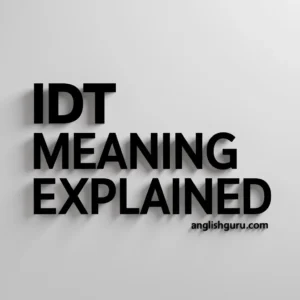When you hear the term “hairpin”, you might first think of the tiny accessory used to secure hair. But like many words in English, hairpin has more than one meaning. Beyond its literal sense, it is also used in figurative, technical, and slang contexts. Whether in sports, driving, conversations, or texting, this word can take on different shades of meaning.
In this article, we will explore 18+ interpretations and uses of “hairpin”, along with polite, professional, and casual alternatives that help you adapt the word depending on your situation. We’ll also compare it with phrases like “asl meaning in text”, giving you an insight into how words and phrases evolve in digital communication.
By the end, you’ll understand not just the word itself, but also how to use it naturally in conversation, formal writing, and casual texting. Plus, you’ll find 11 texting examples that are simple, clear, and SEO-friendly.
1. The Literal Hairpin Meaning
The most common meaning of “hairpin” refers to a small device used to fasten hair in place. Traditionally made of metal, plastic, or wood, hairpins have been used by people across cultures and have held symbolic roles in history, fashion, and even ceremonies.
- Casual context: “I can’t find my hairpin. Did you see it on the table?”
- Professional context: “The hairpin in this traditional attire adds cultural significance to the outfit.”
2. Hairpin in Driving and Sports
In racing, cycling, and skiing, a hairpin turn means a very sharp bend in the road or track that resembles the shape of a hairpin. Drivers often need to slow down drastically to navigate these curves.
- Casual context: “That hill road has so many hairpin bends; it was thrilling but scary!”
- Professional context: “The track’s hairpin curve is one of the most challenging features for drivers.”
3. Hairpin in Scientific Terminology
In biology and chemistry, “hairpin” can describe a structural shape where a strand folds back on itself, resembling a hairpin. For example, in genetics, hairpin loops form when DNA or RNA strands fold and pair internally.
- Casual context: “I read about DNA making a hairpin shape—it’s fascinating.”
- Professional context: “The protein displayed a hairpin loop essential for stability.”
4. Hairpin as a Metaphor for Sudden Change
In language, “hairpin” is sometimes used metaphorically to describe an abrupt shift or reversal.
- Casual: “His mood took a hairpin turn after hearing the news.”
- Professional: “The company’s strategy made a hairpin change after the market crash.”
5. Hairpin in Literature and Expression
Authors and poets often use “hairpin” symbolically to describe fragility, precision, or suddenness.
- Example: “Her life spun around a hairpin decision.”
6. Comparing Hairpin with “ASL Meaning in Text”
Much like “ASL” in texting (which often stands for “age, sex, location”), “hairpin” shifts meaning depending on its context. Both illustrate how language adapts in professional, casual, and digital spaces.
For clarity:
- Hairpin: Can mean a literal accessory, a road curve, or a metaphorical shift.
- ASL in text: Context-driven, informal, often used in online chats.
The takeaway? Always judge meaning based on tone and setting.
7. Professional Alternatives to “Hairpin Turn”
Instead of saying “hairpin turn” in formal documents, you can use:
- “Sharp bend”
- “Tight curve”
- “Critical angle”
8. Casual Alternatives to “Hairpin”
In everyday conversations, people often simplify:
- “That crazy bend on the road”
- “A twisty turn”
- “Loop-like corner”
9. Hairpin vs. Sudden Twist
“Hairpin” can often be replaced by “sudden twist,” “sharp change,” or “unexpected shift” in metaphors.
Example:
- “Her career took a sudden twist after the opportunity.”
- “The movie had a sharp change in the storyline.”
10. Cultural Significance of Hairpins
In some cultures, hairpins symbolize status, love, or maturity. For example, in ancient China, hairpins were gifted as tokens of affection.
- Professional: “The hairpin ceremony marked her coming of age.”
- Casual: “That antique hairpin looks so elegant.”
11. Choosing the Best Alternative by Context
When should you use “hairpin” and when should you pick a synonym?
- Formal writing: Use “sharp bend,” “abrupt shift,” or “structural loop.”
- Casual chats: Stick with “hairpin bend” or “twisty road.”
- Texting: Simplify with “sharp turn” or “sudden change.”
12. 11 Texting Examples Using Hairpin & Alternatives
Here are SEO-friendly texting examples that show how to use “hairpin” in conversations naturally:
- Friend to friend: “Bro, that mountain road had so many hairpin bends 😳.”
- Travel chat: “The view after the hairpin turn was amazing!”
- Gaming context: “That racing game’s hairpin curve is impossible to pass!”
- Science nerd chat: “Just read about DNA forming a hairpin loop—so cool 🔬.”
- Motivational text: “Life can take hairpin turns, but you’ll handle it 💪.”
- Casual advice: “Slow down at the hairpin bend, it’s dangerous.”
- Romantic hint: “Your gift was like a hairpin twist in my day 💕.”
- College group chat: “Professor mentioned hairpin loops in RNA today 🧬.”
- Family text: “Be careful on that road, it’s full of hairpin curves.”
- Storytelling text: “The movie had a hairpin twist at the end!”
- Reflective tone: “Sometimes life’s hairpin turns lead to the best views.”
13. Final Thoughts
The word “hairpin” is far more versatile than most people realize. From its literal use in fashion and culture to its figurative meanings in sports, science, and daily conversations, it adapts beautifully across contexts.
Much like “asl meaning in text”, the lesson here is that context shapes meaning. Whether you’re writing formally, chatting casually, or texting quickly, choosing the right alternative expression helps your words come across clearly and appropriately.
By learning these 18+ hairpin meanings and synonyms, you’ll be better equipped to use the word (or its alternatives) in a way that fits your situation perfectly.





